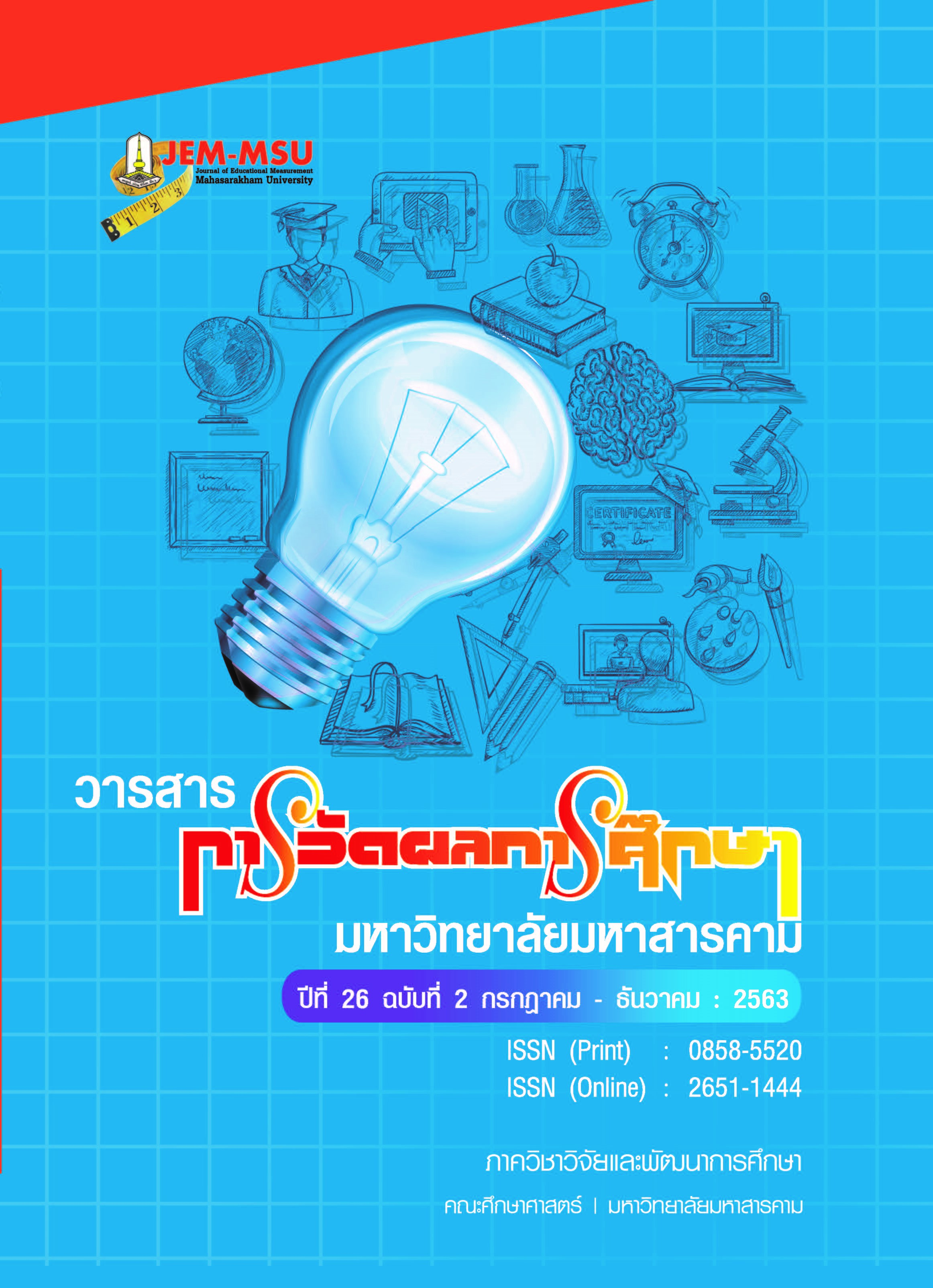Development of a Community of Inquiry Model to Promote Higher-Order Thinking Skills of Student Teachers
Main Article Content
Abstract
The purpose of this research and development was to develop and study the effect of using the community of inquiry model to promote higher-order thinking skills of student teachers. The research was divided into 2 phases. Phase 1 dealt with the development of the community of inquiry model to promote higher-order thinking skills of student teachers. The informants were 5 certified scholars, obtained through purposive sampling. Phase 2 dealt with the experimentation and the study of the results of using the community of inquiry model to promote higher-order thinking skills of student teachers. The population consisted of 282 third year Bachelor of Education Program students who were studying the Learning Measurement and Evaluation course in the academic year 2018 at the Faculty of Education, Phranakhon Si Ayutthaya Rajabhat University. The sample consisted of 87 social studies majors, physical education majors, and special education and the Thai Language Teaching majors, obtained through cluster random sampling. The research instruments were the community of inquiry model to promote higher-order thinking skills of student teachers, a rating scale and a higher-order thinking skills test. The statistics employed in the analysis of data were the mean, standard deviation and t-test for dependent samples. The research results were as follows:
1. The community of inquiry model that had been developed to promote higher-order thinking skills of student teachers consisted of 6 components: background and importance of the problem, objectives, principles, steps of organizing for learning, media and learning sources, and measurement and evaluation. There were 5 steps of organizing for learning, known as the “3STA.” It comprised self-learning, social learning, knowledge sharing, teaching, and assessing. The community of inquiry model had the overall evaluation results of propriety at the highest level.
2. The results of using the community of inquiry model to promote higher-order thinking skills of student teachers revealed that after using the model the student teachers had higher scores of higher-order thinking skills than before using it, with statistical significance at the .05 level.
Article Details
The content and information contained in the published article in the Journal of Educational Measurement Mahasarakham University represent the opinions and responsibilities of the authors directly. The editorial board of the journal is not necessarily in agreement with or responsible for any of the content.
The articles, data, content, images, etc. that have been published in the Journal of Educational Measurement Mahasarakham University are copyrighted by the journal. If any individual or organization wishes to reproduce or perform any actions involving the entirety or any part of the content, they must obtain written permission from the Journal of Educational Measurement Mahasarakham University.
References
เชษฐา แก้วพรม. (2556). การพัฒนาทักษะการสะท้อนคิดของนักศึกษาพยาบาลด้วยการเขียนบันทึกการเรียนรู้ในรายวิชาการสอนและการให้คำปรึกษาทางสุขภาพ. วารสารวิทยาลัยพยาบาลพระปกเกล้าจันทบุรี, 24(2), 12-20.
ทิศนา แขมมณี และคณะ. (2549). การนำเสนอรูปแบบเสริมสร้างทักษะการคิดขั้นสูงของนิสิตนักศึกษาครูระดับปริญญาตรี สำหรับหลักสูตรครุศึกษา. คณะครุศาสตร์ จุฬาลงกรณ์มหาวิทยาลัย : กรุงเทพฯ.
ทิศนา แขมมณี. (2550). ศาสตร์การสอน. พิมพ์ครั้งที่ 6 ฉบับเพิ่มเติม. กรุงเทพฯ: จุฬาลงกรณ์มหาวิทยาลัย.
บรรจง อมรชีวิน. (2554). Thinking School สอนให้คิด. กรุงเทพฯ : ภาพพิมพ์.
ปัทมศิริ ธีรานุรักษ์. (2544). ผลของการใช้กระบวนการเรียนการสอนตามแนวการสอนแบบชุมชนแห่งการสืบสอบเชิงปรัชญาที่มีต่อทักษะการคิดของเด็กชั้นประถมศึกษาปีที่ 1. ปริญญาครุศาสตรดุษฎีบัณฑิต สาขาวิชาหลักสูตรและการสอน คณะครุศาสตร์ จุฬาลงกรณ์มหาวิทยาลัย กรุงเทพฯ.
ปิยาภรณ์ พุ่มแก้ว. (2562). การพัฒนารูปแบบการจัดการเรียนรู้เพื่อเสริมสร้างความสามารถในการสะท้อนคิดของนักศึกษาครู. วารสารการวัดผลการศึกษา มหาวิทยาลัยมหาสารคาม, 25(1), 188-205.
ไพฑูรย์ สินลารัตน์. (2556). ครูยุคศตวรรษที่ 21.[ออนไลน์]. ได้จากhttp://seminar.qlf.or.th/File/DownloadFile/ [สืบค้นเมื่อ 27 ธันวาคม 2562].
ฤทัยรัตน์ ธรเสนา. (2546). การพัฒนารูปแบบการเรียนการสอนแบบช่วยเสริมศักยภาพเพื่อส่งเสริมทักษะการคิดขั้นสูงของนักศึกษาพยาบาล. ปริญญาครุศาสตรดุษฎีบัณฑิต สาขาวิชาหลักสูตรและการสอน คณะครุศาสตร์ จุฬาลงกรณ์มหาวิทยาลัย กรุงเทพฯ.
วัชรา เล่าเรียนดี. (2554). รูปแบบและกลยุทธ์การจัดการเรียนรู้เพื่อพัฒนาทักษะการคิด. พิมพ์ครั้งที่ 8. นครปฐม : โรงพิมพ์มหาวิทยาลัยศิลปากร.
วิจารณ์ พานิช. (2555). วิถีสร้างการเรียนรู้เพื่อศิษย์ในศตวรรษที่ 21. กรุงเทพฯ : มูลนิธิสดศรี-สฤษดิ์วงศ์.
สำนักงานเลขาธิการสภาการศึกษา. (2552). กรอบมาตรฐานคุณวุฒิระดับอุดมศึกษาแห่งชาติ พ.ศ. 2552. ประกาศกระทรวงศึกษาธิการ.
Beyer, B. K. (1997). Improving Students Thinking: A Comprehensive Approach. Boston: Allyn and Bacon, Inc.
Biological Science Curriculum Standard: BSCS. (2006). The BSCS 5E Instructional Model : Origins and Effectiveness. [n.p.].
Davis, G.A., & Rimm, S.B. (1994). Education of the Gifted and Talented. 3rd ed. Boston:Allyn and Bacon.
Demissie, F. (2015). Promoting Student Teachers’ Reflective Thinking Through a Philosophical Community of Enquiry Approach. Australian Journal of Teacher Education, 40(12).
Freakley, M., & Burgh, G. (2000). Engaging with Ethic: Ethical Inquiry for Teachers.Australia: Social Science Press.
Higuchi, K.A., & Donald, J.G. (2002). Thinking Processes Used by Nurses in Clinical Decision Making. Journal of Nursing Education, 41(4), 145-153.
Keeves, P. J. (1988). Model and Model Building. Educational research. Methodology and Measurement: An international Handbook. Oxford: Pergamon Press.
Shea, P. & Bidjerano, T. (2009). Cognitive presence and online learner engagement: a cluster analysis of the community of inquiry framework. Journal of Computing in Higher Education, 21, 199–217.
Williams, R., & Wessel, J. (2004). Reflective journal writing to obtain student feedback about their learning during the study of chronic musculoskeletal conditions. Journal of Applied Health, 33(1), 17-23.
Yule, S. and Glaser, J. (1994). Classroom Dialogue and the Teaching of Thinking. Research Report: The University of Melbourne.


